In Ardmore, African-Americans had settled largely on the "Eastside" of the city, to the east of the Santa Fe Railroad tracks. Many had left the city during the Second World War and the decades therafter, so the black population of the city was gradually dwindling anyway. Prior to de-segregation, the Eastside was the location of the black Douglas High School. There was a black commercial district on East Main Street and numerous black-owned businesses in the area, especially around the High School. When the schools were de-segregated, Douglas was abandoned and the black students went to Ardmore High School, black residents of the Eastside could shop and live in the formerly white part of the city, and the Eastside depopulated further. At least desegregation resulted in Ardmore High School having a markedly better football team.
But there were few economic opportunites for African Americans in the area, other than working at the local tire plant. The Eastside was neglected and had many abandoned properties. The first several blocks of East Main Steet, which began at the railroad tracks, became a haven for a booming drug trade, practiced openly in daylight as well as night, with young black entrepreneurs taking advantage of one of the few economic opportunities available. A local police office told me that people driving from Dallas or from Oklahoma City knew which exit from I-35 to take and knew to drive to East Main Street to buy their drugs. And would head right back to the interstate after buying them.
Ardmore had a problem. But it seemed that the new generation of drug dealers was descended from former generations of boot-leggers and those who sold alcohol the Indians in the Territory Days.
More on Ardmore's Eastside here.
The Oil Boom and Teapot Dome Scandal
When Oklahoma became a state in 1907, Ardmore was no longer in Indian Territory but was still the capital of Carter County. As the cotton growing industry collapsed in the early 1900s when the land simply "played out" from growing cotton, Ardmore was lucky enough to be adjacent to the Healdton Oil Field, where oil was "discovered" in 1913. A prospector in 1893 had drilled a shallow well in Healdton near an oil seep in 1893, but federal law at that time forbade oil exploration or development in Indian Territory. With statehood, that proscription no longer existed, and an oil book soon followed. Many fortunes were made in those days, and some oil exploration and development companies are still located in Ardmore. Also, once Indian lands were no longer held communally but in individual allotments, many of those allotments quickly ended up in white hands.
With the oil boom, Ardmore became more prosperous. There had been a large fire in 1995 and the downtown had been almost entirely rebuilt in brick and stone. There was a particularly large and luxurious hotel downtown, The Randol Hotel, rumored to be connected by tunnels beneath Main Street connecting it to nearby entertainment venues so that couples could discreetly enter the hotel unseen.
The Randol was also rumored to be the place where the Teapot Dome plot was hatched, involving an interesting character named Jake Hamon.
Jake was originally from Kansas. He had a law degree and first showed up in Lawton around 1900, where he was the City Attorney, and soon the Mayor. He was removed from office in 1903 for corruption and extortion. He went on to become the Chairman of the Oklahoma Indian Territory Republican Committee, and by 1909 was a lobbiest in Washington. He became chairman of the Oklahoma Territory Republican National Committee.[2] In 1909, he was a lobbyist in Washington, D. C., but in 1910 was accused of attempting to bribe a U. S. Senator for a favorable vote on land contracts with the Chicasaw-Choctaw Nation in Carter County, contracts that would have been very profitable for Hamon. He was investigated by congress, but no action taken.
Hamon showed up in Ardmore in 1912, and was involved with circus owner John Ringling in building a railroad line from Ardmore to Ringling, Oklahoma, a town named for Ringling, probably in an attempt to foster its growth and development. But, with the "discovery" of oil in Healdton, Hamon (and Ringling) soon directed their attention to the oil business there. Hamon made a great deal of money in the next years.
In 1920, Hamon was elected a member of the Oklahoma Republican National Committee. and helped to broker the dealings that led to the selection of Warren Harding as the Republican nominee for President. After Harding was elected, Hamon was rumored to be in line for a cabinet post, as Secretary of the Interior.
In the meantime, Hamon had become estranged from his wife, Georgia, and involved with a young mistress, Clara Belle Smith, whom he had met in Lawton. Georgia had found out about the affair, and had moved to Chicago with her two children. Hamon and Clara moved into adjoining rooms at the Randol in Ardmore, and all seemed fine until Hamon met Harding and learned that Mrs. Harding was a cousin of Georgia. Harding is further rumored to have made any offer of a position contingent upon Hamon moving to Washington with his "legitimate family".
An associate of Harding came to Ardmore in late November to meet with Hamon and discuss the latter's role in the Harding administration. At a private dinner with the guest, Hamon and Clara had an argument, and Clara went back to her room. Hamon later went to Clara's room and shortl afterward came downstairs with a gunshot wound in the abdomen. He died five days later, claiming he had accidentally shot himself while cleaning his gun, and ordering a friend to take Clara to Mexico.
Clara was subsequently charged with Hamon's murder and stood trial for it. The trial and the case was quite sensational at the time, and testimony went on for a week. In the end, the jury acquited Clara after 39 minutes of deliberation. According to a lawyer acquaintance of mine, the defense strategy was to put Clara on the stand and ask simply "Can anyone who looks like this be a murderer?"
In Ardmore, Hamon was rumored to be part of the conspiracy that ended up as the Teapot Dome Scandal, involving oil reseves in Wyoming. It was the man, Albert Ball, who did become Harding's Secretary of the Interior that ended up in prison for his role in the scheme. And Hamon? Who knows what role he had in the plot.
The Randol is gone. But the tunnels are rumored to still exist. During a bank renovation, while excavating for the vault, the constrution enountered part of a tunnel. Other parts are said to have been incorporated into the storm drainage system for the city. The storm drain tunnels and the surviving other tunnels are also said to have been used by those who smuggled alcohol into Indian Territory, and later by bootleggers during prohibition. At the time we lived there, Ardmore was a significant drug distribution point. And maybe the decendents of the bootlegger decendents of the orginal alcohol smugglers used the tunnels for drugs today. I don't know, but I suspect not, as an exploration of the storm drains done by myself and several others in 1998 failed to turn up anything other than storm drains.
We did not know much about the colorful history of Ardmore and of Oklahoma when we decided to move there. But we had met many Ardmorites and Oklahomans, who seemed very nice, and we were made to feel welcome even before we arrived. We had about five months to get ready for the move.
The next process, or processes involved a monumental down-sizing. The farmhouse had four bedrooms and two bathrooms. The "ell" had the firewood shed, a wood working shop, and a garage on the first level, and a loft above. The barn had the animal quarters and equipment storage on the north side, the center with the old apple cooler, and the south side with the former yarn shop and office, and another small workshop for model-making. The barn was about 40 feet wide and 90 feet long, the ell was about 75 feet long, and the house was about 2400 square feet. And all this space was full. We still had the farm equipment and eight jeeps in various stages of restoration, looms and weaving equipment, tools and supplies, and all the accumulated stuff of some 20 years of living there.
Once we got started, the process went pretty fast. We found buyers for most of the jeeps and the farm equipment including the apple bins, the wind machine and the tractor and sprayer. We had months of road-side yard sales and trips to local charities and the landfill, but we managed to reduce our posessions considerably. We even sold of parcels of land from the farm, reducing the size to about 55 acres, before listing it with a realtor for sale.
But with all that effort, we still had a lot of stuff. We found a four bedroom home to rent on the southwest side of Ardmore and did the move in two stages. One part was the household goods done by a professional. The other was a large U-Haul truck, towing a trailer carrying the M-38 jeep, driven by Gene in early July from New Hampshire to Oklahoma.
In addition to the house, we rented a 20 x 60 storage unit for the contents of the U-Haul, which included a second CJ2A jeep, a spare jeep motor, a canoe, a kayak, woodworking tools, and hardwood lumber. We nearly filled that unit, and despite continuing efforts to down-size it was four years before we got it emptied out.
Gene commuted to work in the M-38 for a several months, until we bought a used Pontiac Bonneville (think Caprice Classic) from a local dealer, since air conditioning was a necessity in the Oklahoma summers, and a heater in the winter, neither of which the M-38 had. Later, when the tornado hit the house, it disabled the jeep by pushing it into the back wall of the garage and pushing the back wall back about a foot. The jeep needed some extensive repairs, But the Pontiac took everything in stride. It may be running still.
Soon after Ellen and the boys made the move, she got a job at the Chicasaw Library system, a regional public library branch in Ardmore. Her work included a "story time", in character as "Mother Goose", and her work there was a fun introduction to the community and a great staff.

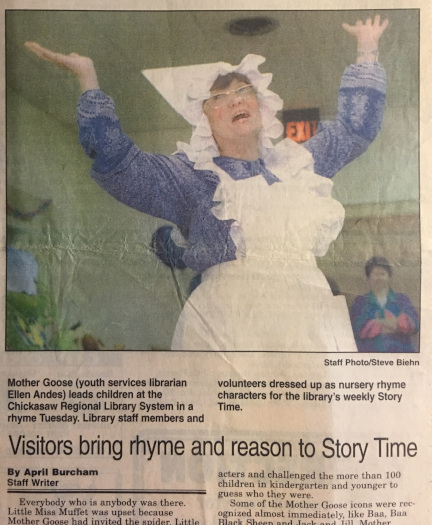
The Ardmore Tornado of 1995
On one of our first tours of Ardmore, a lovely person, Mollyann Cypert, who later became a good friend, drove us around the city. Gene noted and commented upon a large billboard near the Interstate which advised people about emergency preparation for tornados. We asked Mollyann about that, and she reassured us that "Ardmore never gets a tornado". Mollyann was wrong about that. Something we reminded her of often in the future, but also something for which we forgave her.
Here are pictures of the two of us in front of our new home and the entire family in the garage.
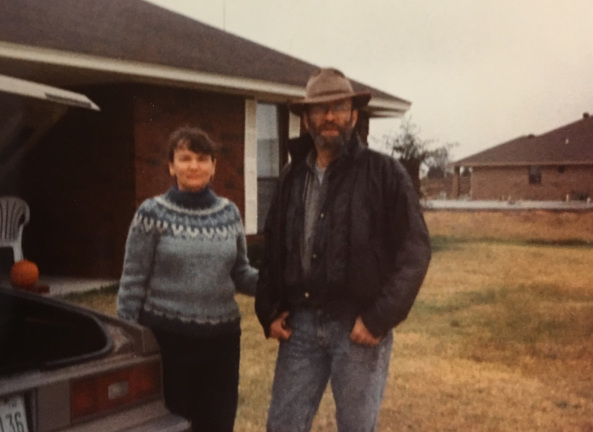
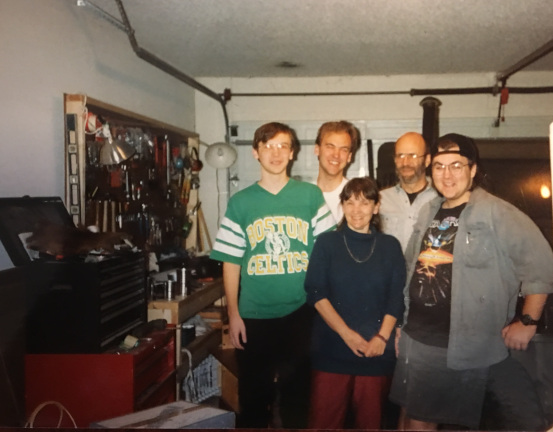
We had settled into our new home and were getting to know Ardmore and the people of the city. The holidays in our new town were very pleasant and the weather much warmer than New Hampshire, and little snow although the winter did provide a couple of impressive ice storms. In spring, the weather was impressive for the storms as the warm humid air from the Gulf of Mexico moving north west met the cold dry air of the great plains moving south east. In May of 1995, a tornado hit our street and passed close to the nearby Plainview High School before directly hitting the local UniRoyal tire plant. Tornados are impressive.
For this one, we had ample warning that there was a danger, but ignored it, as there had been multiple alerts in the preceeding week. We did listen to the radio and heard that a tornado was "on the ground" south of Ardmore and headed north. When we saw a neighbor who was out in the street in the rain looking to the south suddenly run into his house, we headed to the central bathroom to take cover. Rich and Rob in first, the Ellen, then Gene, who just got into the space before a large 2 x 4 struck the doorframe. The whole thing was over in less than a minute, and we came out of the bathroom to a transformed house. The entire place glistened with shiny fragments of the boys' CD collections mixed with fibreglass insulation from our house and neighbors' houses. The tornado had torn off about a third of the roof shingles and had lifted the entire roof of the house up about a foot, then dropped it back down in place. The wall electric receptacles had been pulled into the wall and up about a foot. The curtains in the living room now were outside the windows; they were still attached to the curtain rods, but now passed up to the joint between wall and ceiling, then outside and down. At a glance, they looked alright. Until you noticed they were hanging outside. No one was hurt, despite our foolishness. But the place was a mess, as the pictures show. The house next door was flattened. Ours had roof damage. The next house was fine. The tornado was a small, narrow one, and had zig-zagged along our street, leaving a strange intermittent trail of destruction.
After the funnel passed through, the the rains began in earnest. A few of us checked on the damaged houses to see if there were any injured people needing help or extrication. There weren't. And within perhaps 30 or 40 minutes, the local Oklahomans arrived to help. They arrived in pick up trucks hauling trailers with tools. The arrived in cars. They helped to finish the search for survivors.
And then a truckload of plywood arrived. And we nailed some up over broken windows to try to keep the rain out, but it came in through the open roof anyway. Our family left after a couple of hours, and found a couple of rooms at a local motel, which would be our home for the next month or so. We contacted our insurance agent and Gene went into work at the hospital. Despite severe damage in the area to the south and to the city itself, there were no deaths, although one older gentleman had been swept up by the wind and carried about a quarter of a mile befoe being deposited in a field. He was bruised a bit and shaken up, but alive and without serious injuries.
Early the next day we went back to our home to assess damage. The rain had slacked somewhat, and there was a Salvation Army coffee truck on the street. We found a brand new heavy duty one hundred foot extension cord on our front porch. We found our furniture pushed to the center of each room and carefully covered by plastic. Years later, I worked with a lovely man, Vernon Elwell, who had brought the electric cords to each house on the street. He told me that he had "wanted to do something to help, and thought that there might be generators on site soon and the homeowners would need the cords to get the power. So he went to a local hardware/supply store and bought every heavy duty extension cord they had, drove out to the neighborhood that night and put one on every porch. I also found out from another friend, with whom I had worked for years, that he was one of a Baptist Men's group that had gone out in the middle of the night and pushed the furniture into the middle of the room in each house that was damaged and covered it with plastic. They did this because, as Oklahomans, they knew that insurance companies might deny coverage for rain damage if the policy owner did not make reasonable attempts to mitigate or prevent rain damage due to roof damage from the tornado.
The next weeks were an introduction to how the insurance industry works. We had excellent coverage, but it was for "replacement value" of household goods. Which meant we had to inventory everything we could and everything we discared and everything we replaced. Fortunately, the company soon sent an experienced adjuster to handle the multiple claims. This individual specialized in handling claims from disasters like this one, and eventually things smoothed out and worked out pretty well.
The tornado was not a very strong one, by Oklahoma standards, a category F3, but it did a great deal of damage. Our home was to the west of the city proper, and the tornado touched down in Love County to our west, where it killed three persons. It was a wide storm and hit the subdivision where we lived, in the area of Plainview High School, in the afternoon of a day of rain and thunderstorms. We stayed in the house and were fortunate that the tornado did not hit us directly. The funnel went along our street, skipping from side to side, so there were intact houses alternating with damaged ones. Several were pretty much flattened. After the storm passed, our street looked like this:
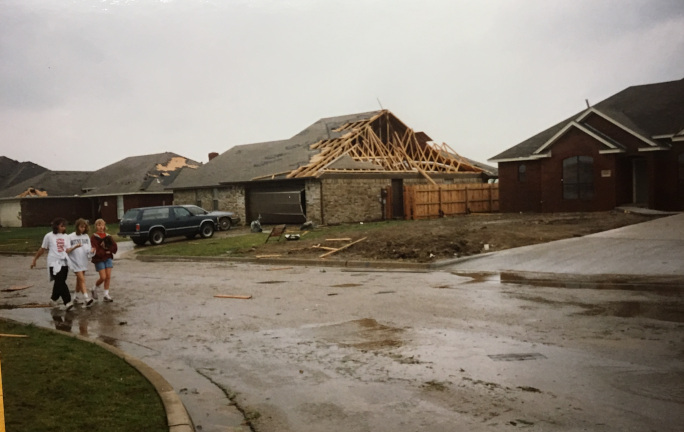

After the storm passed through our neighborhood, it veered a bit and missed the High School. It missed the heart of the city, but did make a direct hit on a tire factory just outside of the city doing much damage, but causing no serious injuries, probably because was a Sunday. There were no fatalities in Ardmore and only minor injuries although total damage was extensive. And expensive.
Our house looked like this. There was plenty of roof damage, and the rains continued heavily
through the rest of that day. With shingles gone, and windows, too, we were taking a lot of water.

The storm had actually lifted the entire roof of the house up about a foot, then dropped it back down, almost exactly in the original position. The house was on a slab, so all the wiring ran through the attic, and the wall receptacles were pulled back into the walls and up about a foot from their original position. Some of the ceilings were missing or damaged. Curtains in several rooms were hanging outside the building. When the roof went up, the curtains blew out between the wall and the ceiling, and when the roof came back down, they were hanging outside the windows. You can see that in these pictures.
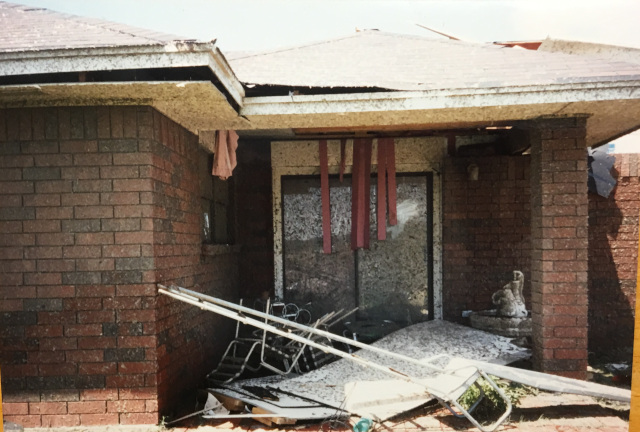
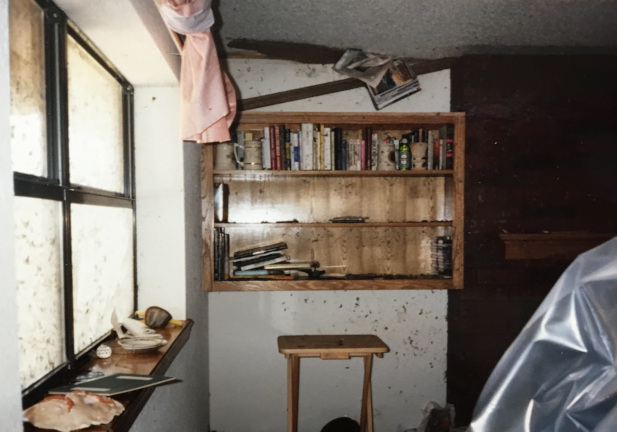

The house inside was very much a mess as the following pictures show. Debris had blown in, brought by the storm from neighboring houses. Much of the house was peppered with fiberglass insulation and broken pieces of lumber. In the pictures below you can see some of this, including one of Ellen's looms and the kids bedrooms. In the garage, under the debris, is my M-38 Jeep. It had been pushed backwards partially through the back wall of the garage. And the ship model is the Rattlesnake, perhaps my first serious attempt at ship modeling, done while we lived in Philadelphia. I saved a few things from it and reused them in later models.
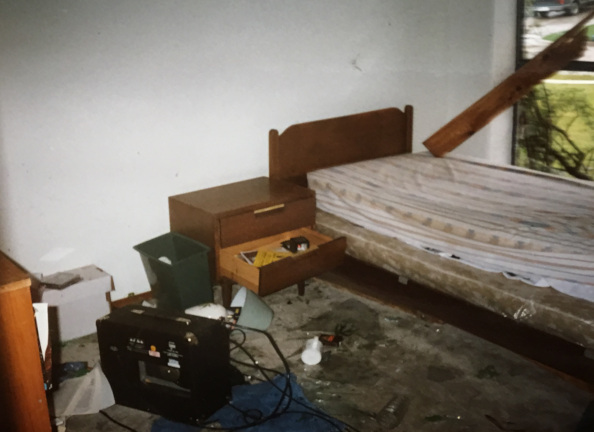
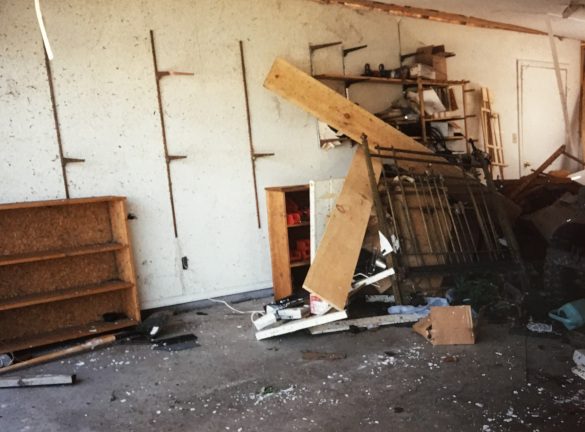
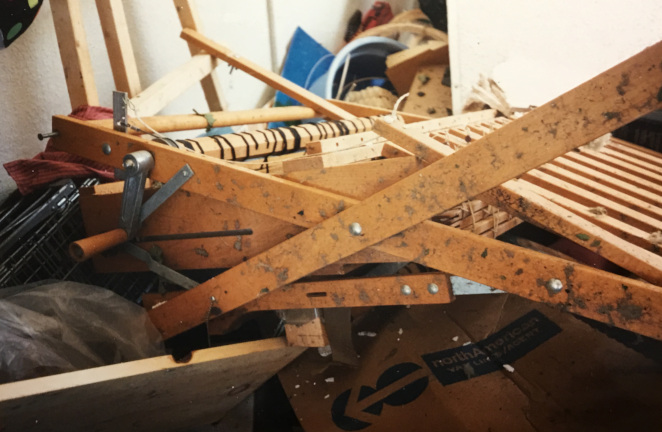
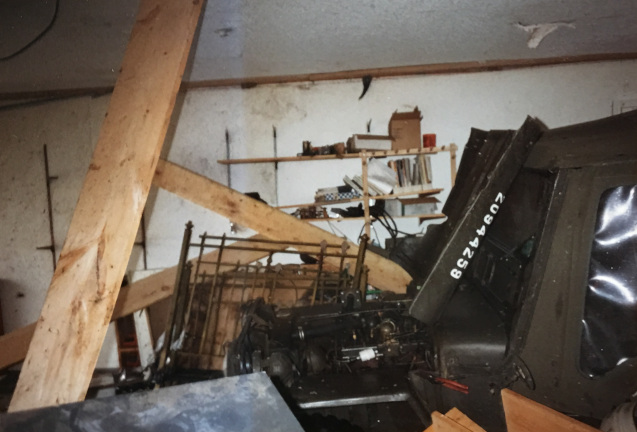
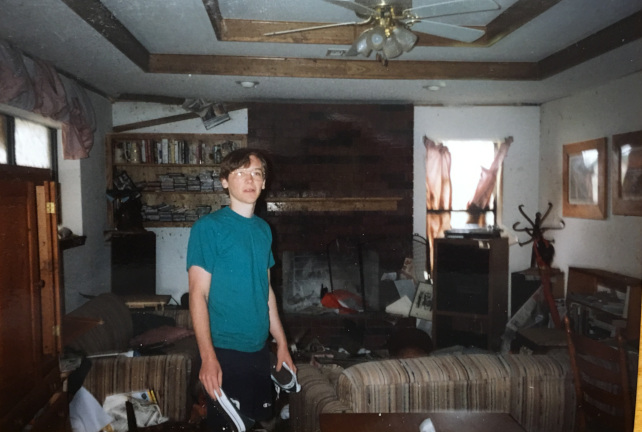
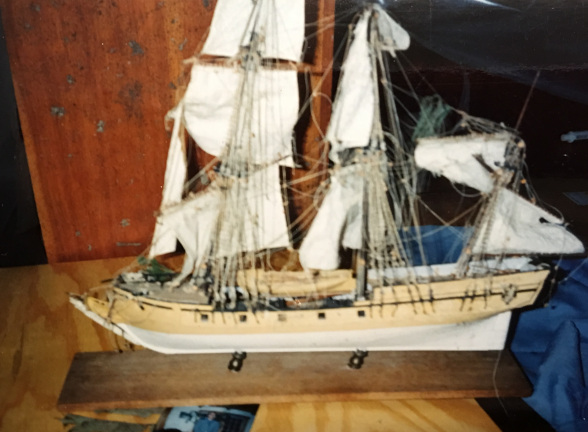
Within a few minutes of the storm's passage, people arrived to offer help. During the rest of that
day and during the night, someone delivered truckloads of plywood so we could board up windows. That night,
a local church men's group came out and went into each home, pulling furniture to the center of each room and
covering it with plastic to protect it from the rain. This because, as Oklahomans, they knew what we did
not, that insurance companies sometimes deny coverage for damage from a tornado if they can deem it
due to the rain that followed it and the policy owner had "failed" to take measures to protect their
property from the rain. Also during the night, a great long heavy duty extension cord appeared on each porch
on our street. Something that was needed within a day when power was available at curbside, but not in each
home. The Salvation Army was there the next day with a coffee truck and snacks. The Red Cross made it to
town about 3 days later.
We were lucky, in that I had gone to town shortly after the storm passed and obtained two motel rooms for us.
All the rooms in town were gone by later that evening, and we ended up staying there for a couple of weeks.
We were also luckier than some of our neighbors. This is the house next to us.
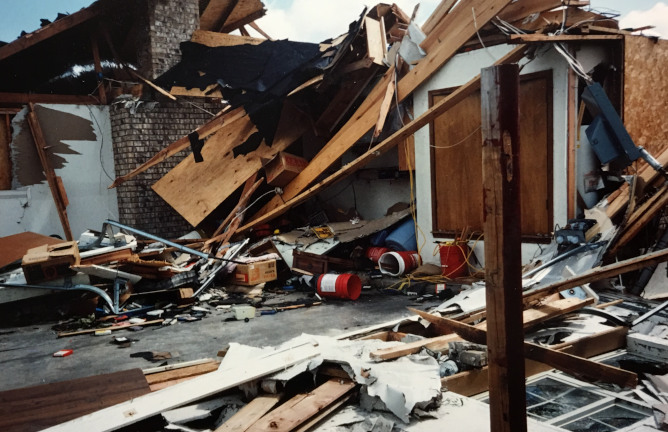
All in all, not a great time, but we were very fortunate to emerge relatively unscathed despite our bone headed decision to not take shelter when the sirens sounded, opting instead to ride it out in our bathroom. Looking at the pictures, you can understand why our next house had a real storm cellar.
In the meantime, a realtor we had been working with found us a new rental just outside town. When we went out to see it, we entered through the garage and as we walked through, the realtor pointed out the entrance to the storm cellar, beneath the garage. "We'll take it!" we said before even entering the house.
The new place was a really nice mid-century four bedroom ranch house, on the site of a former beef cattle ranch. It even had a working oil well in the front yard. And it also came with a dog.
The dog, "Bo", had been the pet of the couple that had lived there when it was a ranch. The gentleman had died some years before, and when his widow sold the ranch and moved into town, the dog could not adjust to city living. So Marnelle showed up one day, with Bo and asked if we could keep her. We did. And Bo was the best dog we ever knew. We lived there for the four more years we stayed in Ardmore. Unfortunately, Bo did not live to leave with us. she disappeared about a year before we left, probably a casualty of the many feral hogs roaming the area.


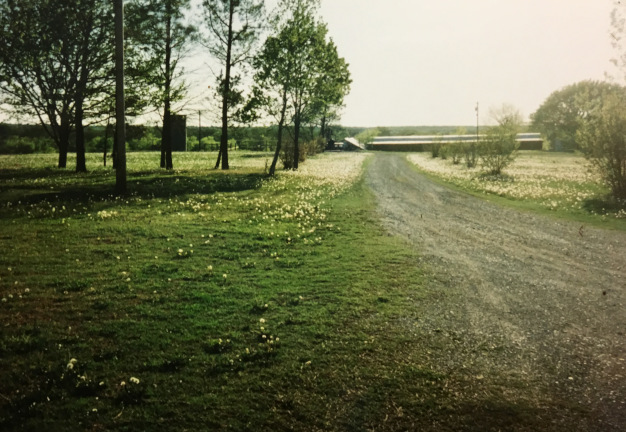
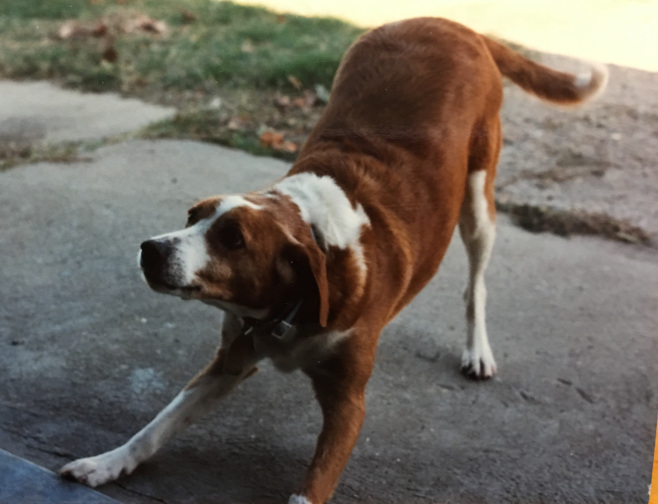

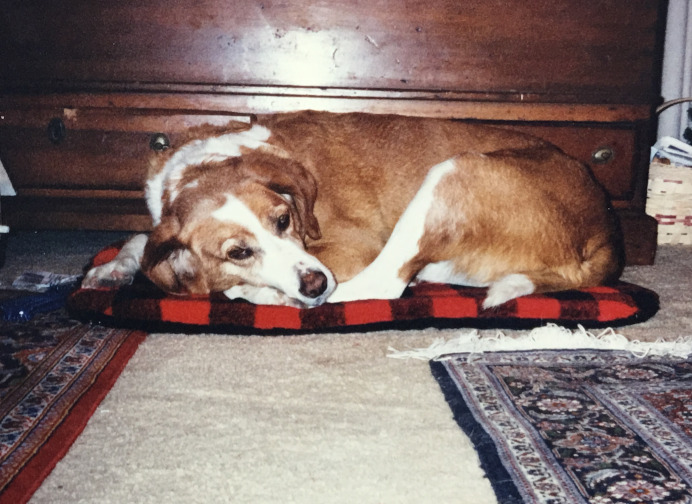
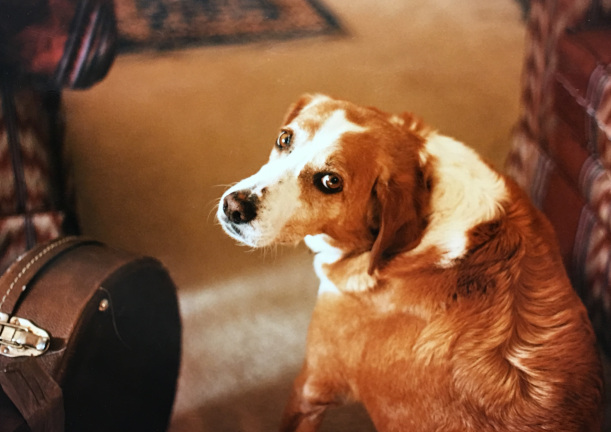
Following are some photos of the interior of the house and the residents and various guests and friends.
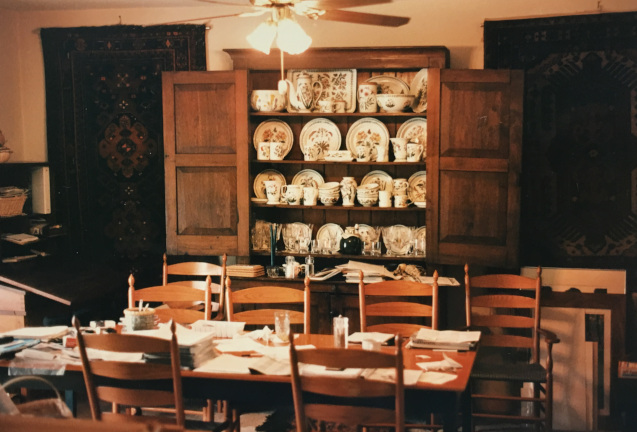
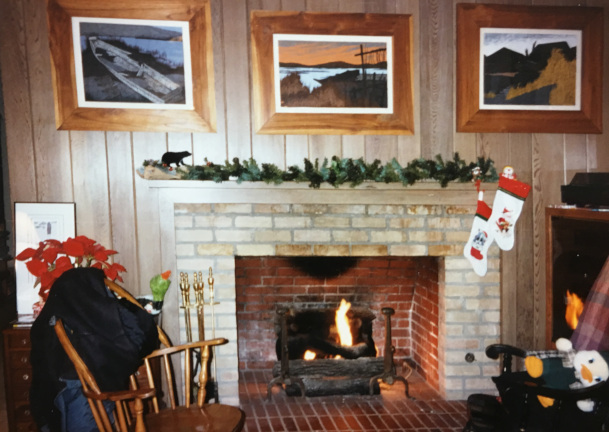
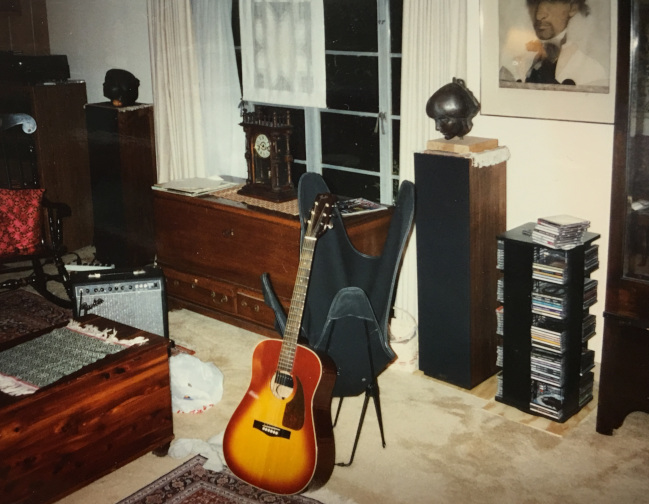
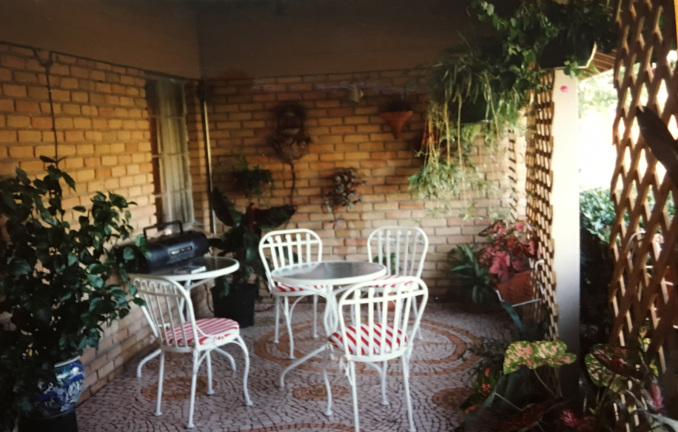
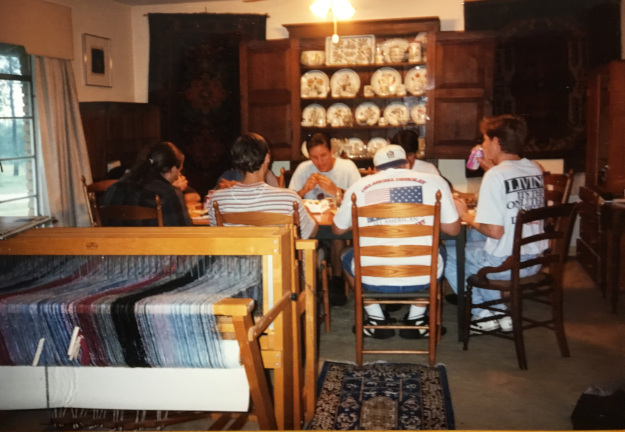
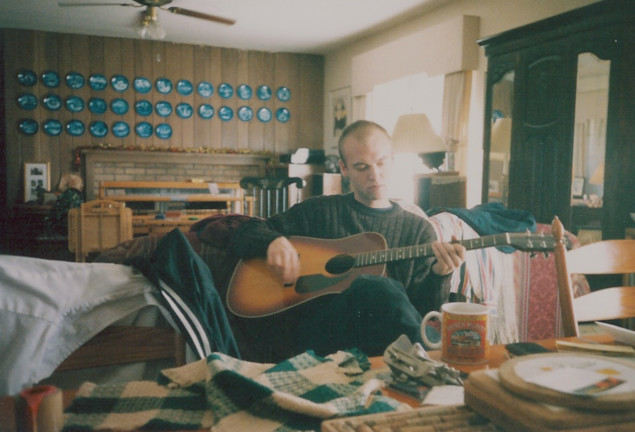
Initially we homeschooled our two younger sons, Rob and Rich. Tom was away at college by this time. Homeschooling is very easy in Oklahoma. In New Hampshire we had to get permission from the local school district to home school. This involved an assessment and a home visit by the head of the district and necessitated a more structured program to pass muster. In Oklahoma, there was no assessment, and we were not even certain we had to notify anybody of our intention. In that state, as perhaps in many, most homeschooling was done for religious reasons and the authorities tended to be very hands off.
Our approach was not based in religious belief but rather a form of "unschooling". Each child was encouraged to find what most interested them and then seek out resources to help them learn about that topic. Rob was interested in biology, art, and music, with side interests in gaming and collecting things. Rich was interested in computers and computer programming, gaming, photography, dragons, and renaissance faires. Each followed their interests and ended up in careers related to them. Rob is a painter and teacher and Rich is a systems engineer for computer-based systems in the broadcasting industry.
We were assisted in our home schooling by the Clonara School program. This is a program that provides resources as needed for children to proceed at their own learning pace. There are some requirements for the student to submit a portfolio and the program leads to a high school diploma if followed through the twelfth grade.
After a couple of years, however, the boys decided they wanted to attend the local high school, Plainview. The reason given was that they wanted to meet girls. So we contacted the principal there and they were "admitted" to Plainview by being allowed to attend whichever courses they wanted to. Rob particularly enjoyed the band, including small group work, and Rich ended up running the computer lab at the school, with another friend. The two boys also did volunteer work at the hospital, spent time with gaming friends, met some girls, and seemed to thrive with the hybrid approach. The administration at Planiview was wonderful and helpful, and at the end, even issued the boys diplomas and allowed them to participate in the graduation ceremonies. Can't say enough good about the administration there.
Here pictures of the boys during this time at Plainview, and their graduation photos.
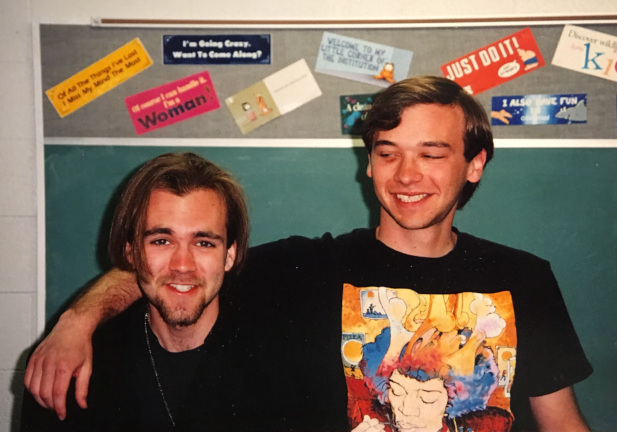

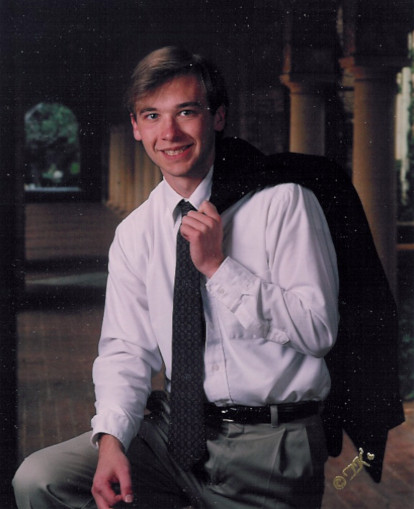
Rob went on to Oklahoma State University where he majored in studio art and got his BFA there in 2003, moving on the get a MFA in painting at the University of Arkansas in 2006. After several years of working as an artist while working as a part time adjunct professor at a nearby community college, he moved on to a full time position as art faculty at Texas Southmost College in Brownsville, Texas.
Rich went to Oklahoma University with a full scholarship in the computer science program, but did not like the program, as it was for engineers not programmers. He did not do well the first year, so switched to English as a major, and continued programming on his own time as well as working at the University TV station, where he taught himself to be a broadcast engineer. When he finished school, he moved directly into a job at a local TV station, then to a similar position in Tulsa, and ultimately to a job with Telestream, a provider of video management systems for television stations.
By late 1998 and early 1999, we were looking to move on from Ardmore. With all the children in college, we felt it was time to relocate to a larger city with easier access to a large metropolitan area with the cultural amenities that would offer. After a job search, Gene found a position at a hospital in Petersburg, Virginia, a city of about 30,000, mostly African American, with a large service area extending into the surrounding suburban and rural areas.
Our adventures in Petersburg are recounted here.
After a couple of years, we got involved as volunteers at the H.F.V. Wilson Center, on
East Main Street. It is a community supported facility providing after school and evening
programs for the children of the Eastside. The children were all African-American and ranged
in age from pre-schoolers to high school students. We did various things at the
center, working with the director, Harold Brown. In time, Gene joined the Board of Directors
and we both did some craft programs and started a rudimentary computer center there.
In time, we met other people living on the Eastside who shared a concern about the open
drug traffic happening on the few blocks of East Main Street adjacent to the railroad
tracks that separated the Eastside from the rest of Ardmore. These several blocks had been
the core of the now largely abandoned black commercial district of Ardmore. The street had
several vacant commercial buildings, some abandoned buildings, overgrown vacant lots, and two
businesses that were still operating, a barber shop and an auto repair garage, the latter located
in the former fire station for the area.
The street also bridged a stone line small canal that was the run off for the street
drainage system for the commercial downtown, on the other side of the tracks. The small
water channel was lined with stone work which looked to be a WPA project, and the bridge
itself was also stone, forming a small tunnel beneath the street. The land adjacent to the
channel was so overgrown with trees, brush, and weeds that the stonework was not visible from
the street. The vacant buildings and the general decayed look of the street provided ample
cover for the young people selling drugs openly on the street, mostly during after school hours
and weekends. Since this part of the street was the "front door" to the Eastside, with the
Wilson Center about 4 blocks further in, it was a poor introduction to the neighborhood.
In our discussions, the small group of us felt that something needed to be done to clean
up that part of the street to discourage the drug trade.
A few informal meetings later,
we decided it was time to stop talking and start doing something about it. The next weekend,
the four of us, Gene, Garry Raymond, John Moore, and Harold Brown, showed up with rakes and shovels
and saws and began clearing the brush and weeds from the vacant lots along those few blocks. Our
presence sharply curtailed the drug business on that day.
Word of our work spread quickly through the community, and the next Saturday, there were perhaps
a dozen volunteers. Gene brought his chain saw, and one of the volunteers used his SUV to begin removing
small trees from along the waterway.
By the next week, there was a second chain saw and a tractor, and the removal of trees and brush
proceeded rapidly. Soon, the land around the waterway was cleared and grass-covered, almost park-like,
and the group decided we needed to create some formal entity to continue the work.
Here is an article from the local paper at the beginning of our clean up campaign. There
was plenty more coverage over the next several year.
Ardmore's "Eastside Renaissance"

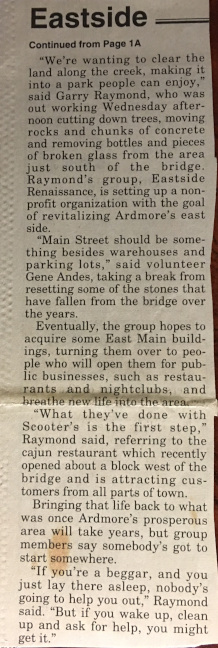
Long story shortened: Gene left the Board of the Wilson Center to work as a volunteer Director for what became the "Eastside Renaissance", ultimately a 501 (c) 3 not-for-profit, dedicated to the urban renewal of the Eastside. Within a year, we had our first grant, and had acquired a major building at the upper end of the Street, adjacent to the tracks, a former two story furniture store and warehouse, which we converted to offices. The Renaissance also acquired multiple other abandoned or vacant properties along the street, mostly through cooperation with the city tax sales. As we cleaned up and secured the first few blocks of East Main, the drug dealers moved over a couple of blocks to Third Street, so we began working there, too, especially when a donor gave us a small house on the street.
Despite the initial successes and general support for the Renaissance from both sides of the track, or perhaps because of the successes, the Board became divided and ultimately the operation of the entity ceased. Gene left as Director, not long before we relocated from Ardmore to Virginia. The experiences gained working within the African American community there were extremely valuable, and the mistakes made as Director were even more valuable.
The Renaissance ceased its work in the community, but community members continued to maintain the cleared areas, although remodeling houses ceased and properties were sold or divested, except the main building and the offices.